For the first two years of my chickening adventures, I used pine shavings as litter inside the coop primarily because they were a common recommendation that was readily available fairly inexpensively. It never occurred to me to use sand inside the chicken coop even though I used sand in the run, but when Facebook fan Kelly V. enthusiastically vouched for sand’s performance in her chicken coops, I had plenty of sand on-hand already, so I figured it couldn’t hurt to experiment. Worst case scenario, I could scoop it out into the run and return to using pine shavings. Pine shavings are a good litter choice, but scientific research and personal experience have proven that sand is even better!
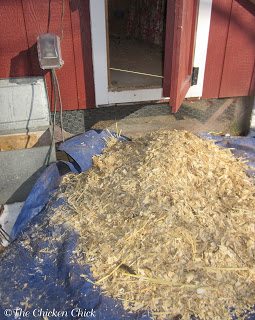
Pine shavings require regular replacement because they absorb moisture and poop is matted to them.
Litter’s primary functions in backyard coops are to keep the coop dry and facilitate cleaning, the most common materials being soft wood shavings, chopped straw and sand. As it turns out, sand is not a novel or modern chicken litter concept; the use of sand is a tried-and-true, old timer’s method of raising laying hens. Poultry visionary, Charles Weeks wrote of the benefits of sand as chicken litter in his 1919 book, “Egg Farming in California,” in which he stated: “Sand is the only material to use on the floors of poultry houses. Clean, dry sand prevents any bacteria from starting. Clean, sharp sand is the freest from dust and easy to keep clean, as the droppings lay on top and are easily lifted off.”
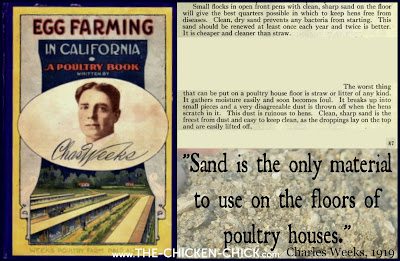
In scientific studies done by the Auburn University Department of Poultry Science, which were borne out by further field testing, sand performed better than pine shavings with lower bacterial counts, lower fungal populations and lower moisture levels. The Auburn research states, “Sand, being inorganic, contains few nutrients that could be utilized by bacteria and, thus, would tend to lead to lower bacterial numbers.” “Additionally, sand may lack binding sites for bacteria.” Straw is a poor choice for litter due to its notorious lack of absorbency, tendency to cause crop impaction, propensity to form manure mats, and inability to control moisture, insects, bacteria levels and ammonia. Similarly, hardwoods shavings such as beech should be avoided due to their propensity to harbor disease causing molds and fungus as well as containing toxic phenol fumes. The last thing I want in my coop was a droppings-laden mat of respiratory trouble and a mite hotel for my chickens.
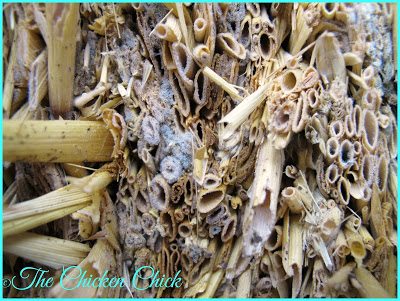
The benefits of sand are many. Sand desiccates droppings, it does not retain moisture or decay, which means less risk of respiratory infections, fewer flies and other insect activity, less bacterial growth, reduced bumblefoot infections and a lower risk of frostbite compared to shavings and straw. There is no risk of crop impaction with sand, in fact, sand is beneficial to the digestive tract since it is used as grit in the gizzard to break down fibrous foods before being passed in the droppings.
Due to its high thermal mass, sand maintains more stable coop temperatures; the Auburn University researchers found that sand keeps chicken houses cooler in the summer and warmer in the winter. The purpose of litter is to keep the environment dry and facilitate waste removal, it is NOT for the purpose of keeping chickens warm in cold weather! Chickens will keep themselves warm with their high body temperatures and feather insulation in a DRY environment. Sand achieves that objective uniquely, creating a healthy living space in all seasons. Dry sand will NOT freeze in freezing temperatures, but any litter that is allowed to get wet in freezing temps will! Learn all about how to help chickens thrive in cold temperatures HERE.
In inclement weather, sand inside the coop is dry and dust-bath ready! Eggs in nest boxes remain cleaner in wet or muddy outdoor conditions because hens’ feet are cleaned and dried while walking through sand to reach nest boxes.
Aesthetically, sand looks cleaner than other litter option and actually is cleaner; the Auburn University researchers found coliform counts, including E.coli, significantly lower in sand than in wood shavings!
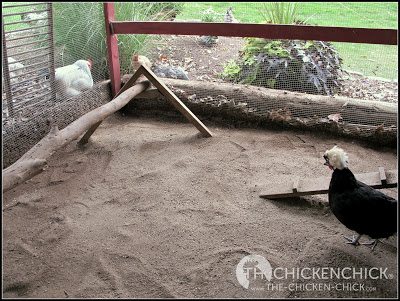
Sand continues to be recommended by poultry experts and veterinarians today. Maryland Poultry Veterinarian, Dr. McKillop, DVM, MSpVM, DACPV states, “Sand is a wonderful litter/ground source for backyard poultry. I advise all of my clients to go from shavings to sand. When it gets wet or rains, it drains, sand is easy to clean, and it’s a wonderful medium for dust bathing. Sand decreases Coccidiosis problems because coccia require warm, damp environments with oxygen to sporulate.” Chickens are able to acquire a natural immunity to coccidiosis gradually without contracting the intestinal disease from an overpopulation of disease-causing oocysts promoted by wet litter.

In her book, Hatching and Brooding Your Own Chicks, esteemed poultry author Gail Damerow discusses sand as brooder bedding, saying, “(Sand) is not as absorbent as other types of bedding, but it absorbs heat more readily and evaporates moisture more rapidly and therefore stays drier. Perhaps for the same reason, sand is more resistant to microbes than other types of bedding, keeping baby birds healthier. Soiled sand doesn’t stick to feet like other types of bedding can. When it is kicked into a drinker, sand doesn’t float and discourage drinking but rather sinks to the bottom so the water remains clean. Provided it is sifted periodically to remove chick poops, sand lasts much longer than other types of bedding, making it extremely economical.” While it is uncommon for baby chicks to ingest litter when feed is available, it’s better to allow them to become accustomed to starter feed for a few days before introducing any litter into the brooder, opting for paper towels instead.
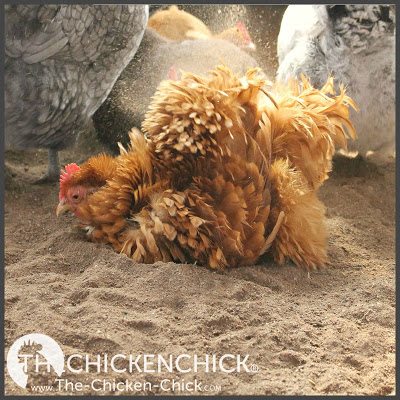

THE IMPORTANCE OF SAND TYPE
The correct sand type goes by a great many different names: washed sand, washed construction grade sand, bank run sand, river sand, equestrian sand, arena sand, etc. The construction supply company I get my sand has changed what they call it from year-to-year, so when sourcing sand, it’s better to see or describe the desired product rather than insist on a certain name. Sand for use as chicken litter and dust baths should be washed, natural and consist of variable particle sizes. It should not be manufactured by crushing quartz. Many play sands are manufactured by crushing quartz, which creates fine, dusty particles that pack closely together, neither of which are desirable features for chicken litter.

Sand can be purchased in bulk at local quarries relatively inexpensively. Every community has a local source of sand for use in construction and landscaping projects. Garden centers, landscaping and construction companies are all good sources. Home improvement centers usually carry bags of sand at a less economical prices than bulk sand, but caution must be used to be certain the sand is natural, not manufactured. I’m not a fan of the bagged sands found at Home Depot & Lowes; it tends to be super dusty even though the bag claims it has been washed.
Newly delivered sand is typically moist from being washed and stored outside. In warm weather, it will dry quickly; raking the sand a few times during the day facilitates drying.
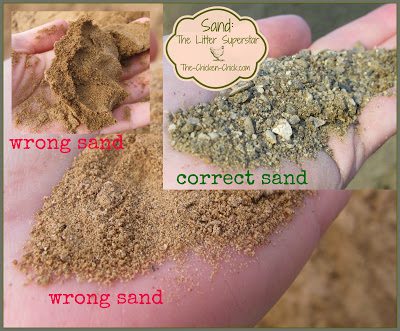
TIPS FOR USING SAND
The drier and cleaner a coop is kept, the healthier the environment for the flock. With all litter types, it is infinitely better not to keep the flock’s drinking water inside the coop! Encourage outdoor activity and a healthy coop by placing water and feed in the chicken yard, which should also eliminate any rodent activity and reduce the fly population in the coop significantly. Chickens are grazers, they must eat and drink in small increments all day long; if food and water is kept inside the coop, chickens are required to come and go (literally and figuratively) in the coop all day long. Chickens spill water and feed and will poop inside all day long if food and water are inside the coop, creating a much dirtier environment than if the food and water is kept outside.
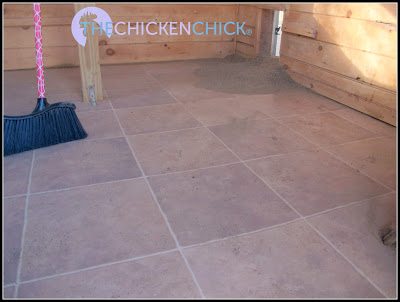
Sand can be used on coop floors that are cement, dirt, or wood. Inexpensive linoleum placed on top of wood flooring before adding sand protects the wood underneath. I use approximately 4 inches of sand inside the chicken coop and as much as a foot in the chicken run. More is better!
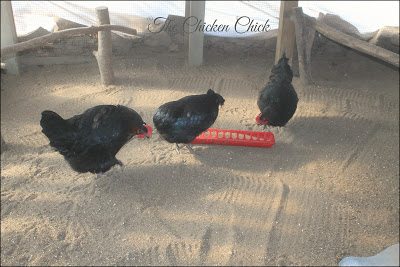
I highly recommend the use of droppings boards underneath the roost to minimize the amount of poop inside the coop. Droppings boards are essentially a shelf that catches droppings produced from chickens roosting at night. Droppings boards are scraped off into a bucket, ordinarily first thing in the morning, then added to compost. I next apply a thin layer of Sweet Coop® to absorb any residual moisture on the droppings boards, creating an inhospitable environment for flies and the generation of ammonia!
Any stray droppings found inside the coop are easily removed with a kitty litter scoop and/or a sifter.
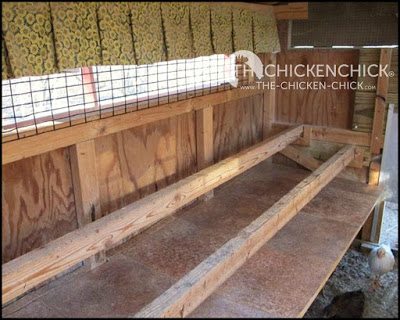
Sweet Coop® is a phenomenal aid in maintaining a dry, fly-free coop! I use it on my droppings boards every time I clean them to eliminate residual moisture. Bonus: it works as a slow-release fertilizer in the garden after being composted with droppings!
The use of sand in the chicken yard or run is ideal in especially wet climates since water drains through the sand instead of creating mud puddles filled with decomposing straw or wood shavings. Roof or cover the chicken run to keep the sand dry and provide the flock an outdoor oasis in inclement weather. Should sand in the chicken run get wet from drinking water, blowing snow or rain, using a roto-tiller or shovel to turn it facilitates drying and keeps the sand fresh and mobile.
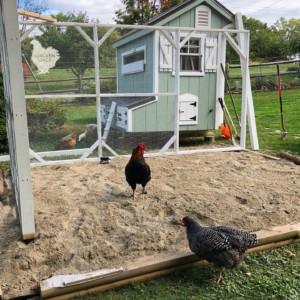
Sand added to the chicken run before the walls and roof are added.
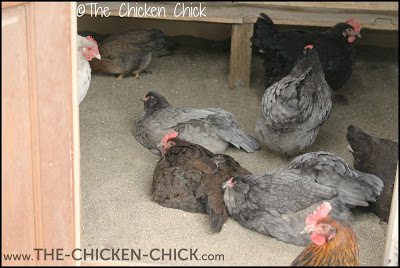
THE CHICKEN RUN
Our chicken run is covered by a roof, but with open sides, rain gets the sand wet from time-to-time. That’s normal. When that happens, I either use a shovel to turn it or roto-tiller to freshen it up. Since it dries up so quickly, once turned, it breaks up easily.
Sweet Coop® Zeolite added to biodegradable litters, and sprinkled onto cleaned droppings boards helps further control any moisture, potential ammonia odor, and flies. Much more information on the benefits of Sweet Coop® Zeolite HERE.
The one disadvantage to sand is its weight. Sand is heavy and may not be a feasible option for physically limited chicken keepers or in large chicken tractors.

BENEFITS OF SAND INSIDE THE COOPS AT-A-GLANCE
- desiccates droppings
- does not retain moisture
- does not decay or degrade inside the coop
- superior drainage
- inexpensive
- Eco-friendly
- natural grit
- no risk of crop impaction as with straw and hay
- easy daily maintenance
- infrequent deep cleaning required
- keeps feet clean and nails manicured
- cleaner feet=cleaner eggs
- any dropped feed gets eaten, not lost in the litter
- dust-bath Mecca!
- no decomposition required in compost pile/great soil amendment especially in clay-heavy soils
- keeps coops cooler in the summer and warmer in winter due to its high thermal mass
- reduces the risk of frostbite
- looks cleaner than other litter options and it is cleaner than other litter options
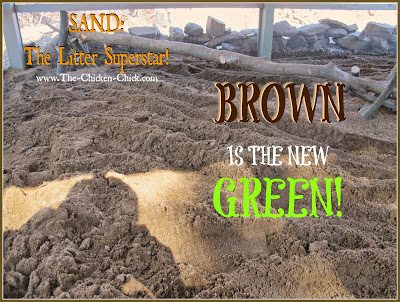
DRAWBACKS OF SAND INSIDE THE COOPS
- heavy to move
- dusty, but so are pine shavings, straw…and chickens, for that matter!
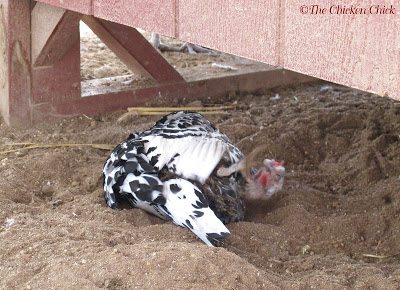
One of the benefits of sand in a covered run is that chickens can dust-bathe all year long. Dry sand sand stays loose even in the coldest temperatures. The photo above was taken in the middle of winter during a week with sub-zero temperatures.
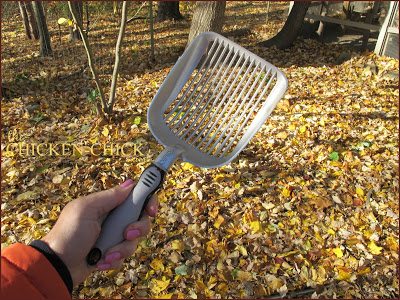
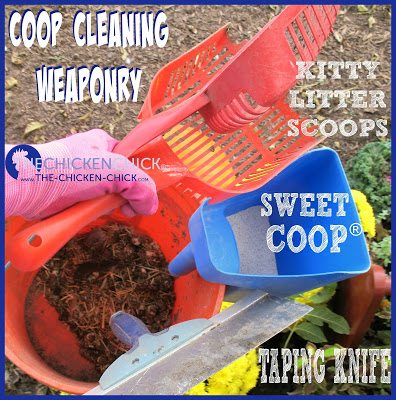
COOP CLEANING TOOLS
12″ drywall taping knife, and corner sand scooper here. Sifting shovels, and sand sifting pans make quick work of cleaning sand in the coop and run.
Click HERE for 5 Tips for a Cleaner Coop with Less Effort
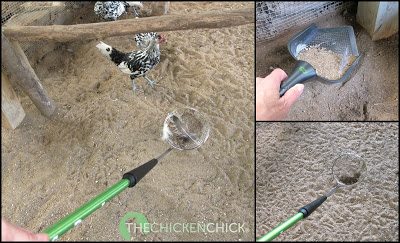
Sand scoopers

References and further reading
Testimonials from chicken-keepers:
Facebook thread #1
Facebook thread #2
Facebook thread #3
Facebook thread #4
Facebook thread #5
Egg Farming in California,
Weeks, Charles, San Francisco, Schwabacher-Frey Stationery Co., 1921
Sand as Litter for Rearing Broiler Chickens
S. F. Bilgili, J. B. Hess, J. P. Blake, K. S. Macklin, and J. L. Sibley, Auburn University, 2005 J. Appl. Poult. Res. 14:238:-245.
Sand as Alternative Litter Material, University of Kentucky 2008
Keeping Garden Chickens in North Carolina. NC State University (Sand as brooder litter & “a perfect ground cover”)
How Sand is Made
Small Flock Series: Managing a Family Laying Flock, University of Missouri Extension
Hatching and Brooding Your Own Chicks, Gail Damerow (Storey Publishing, 2013)
American Veterinary Medical Association
Coop litter choices: “Straw should be checked for mold or contamination prior to use. Hay is inappropriate due to harmful mold spores and dust.”
Alternative Litter Materials for Growing Poultry, Jesse L. Grimes, Extension Turkey Specialist
Kathy Shea Mormino
Affectionately known internationally as The Chicken Chick®, Kathy Shea Mormino shares a fun-loving, informative style to raising backyard chickens. …Read on


shop my SPONSORS
For the first two years of my chickening adventures, I used pine shavings as litter inside the coop primarily because they were a common recommendation that was readily available fairly inexpensively. It never occurred to me to use sand inside the chicken coop even though I used sand in the run, but when Facebook fan Kelly V. enthusiastically vouched for sand’s performance in her chicken coops, I had plenty of sand on-hand already, so I figured it couldn’t hurt to experiment. Worst case scenario, I could scoop it out into the run and return to using pine shavings. Pine shavings are a good litter choice, but scientific research and personal experience have proven that sand is even better!

Pine shavings require regular replacement because they absorb moisture and poop is matted to them.
Litter’s primary functions in backyard coops are to keep the coop dry and facilitate cleaning, the most common materials being soft wood shavings, chopped straw and sand. As it turns out, sand is not a novel or modern chicken litter concept; the use of sand is a tried-and-true, old timer’s method of raising laying hens. Poultry visionary, Charles Weeks wrote of the benefits of sand as chicken litter in his 1919 book, “Egg Farming in California,” in which he stated: “Sand is the only material to use on the floors of poultry houses. Clean, dry sand prevents any bacteria from starting. Clean, sharp sand is the freest from dust and easy to keep clean, as the droppings lay on top and are easily lifted off.”

In scientific studies done by the Auburn University Department of Poultry Science, which were borne out by further field testing, sand performed better than pine shavings with lower bacterial counts, lower fungal populations and lower moisture levels. The Auburn research states, “Sand, being inorganic, contains few nutrients that could be utilized by bacteria and, thus, would tend to lead to lower bacterial numbers.” “Additionally, sand may lack binding sites for bacteria.” Straw is a poor choice for litter due to its notorious lack of absorbency, tendency to cause crop impaction, propensity to form manure mats, and inability to control moisture, insects, bacteria levels and ammonia. Similarly, hardwoods shavings such as beech should be avoided due to their propensity to harbor disease causing molds and fungus as well as containing toxic phenol fumes. The last thing I want in my coop was a droppings-laden mat of respiratory trouble and a mite hotel for my chickens.

The benefits of sand are many. Sand desiccates droppings, it does not retain moisture or decay, which means less risk of respiratory infections, fewer flies and other insect activity, less bacterial growth, reduced bumblefoot infections and a lower risk of frostbite compared to shavings and straw. There is no risk of crop impaction with sand, in fact, sand is beneficial to the digestive tract since it is used as grit in the gizzard to break down fibrous foods before being passed in the droppings.
Due to its high thermal mass, sand maintains more stable coop temperatures; the Auburn University researchers found that sand keeps chicken houses cooler in the summer and warmer in the winter. The purpose of litter is to keep the environment dry and facilitate waste removal, it is NOT for the purpose of keeping chickens warm in cold weather! Chickens will keep themselves warm with their high body temperatures and feather insulation in a DRY environment. Sand achieves that objective uniquely, creating a healthy living space in all seasons. Dry sand will NOT freeze in freezing temperatures, but any litter that is allowed to get wet in freezing temps will! Learn all about how to help chickens thrive in cold temperatures HERE.
In inclement weather, sand inside the coop is dry and dust-bath ready! Eggs in nest boxes remain cleaner in wet or muddy outdoor conditions because hens’ feet are cleaned and dried while walking through sand to reach nest boxes.
Aesthetically, sand looks cleaner than other litter option and actually is cleaner; the Auburn University researchers found coliform counts, including E.coli, significantly lower in sand than in wood shavings!

Sand continues to be recommended by poultry experts and veterinarians today. Maryland Poultry Veterinarian, Dr. McKillop, DVM, MSpVM, DACPV states, “Sand is a wonderful litter/ground source for backyard poultry. I advise all of my clients to go from shavings to sand. When it gets wet or rains, it drains, sand is easy to clean, and it’s a wonderful medium for dust bathing. Sand decreases Coccidiosis problems because coccia require warm, damp environments with oxygen to sporulate.” Chickens are able to acquire a natural immunity to coccidiosis gradually without contracting the intestinal disease from an overpopulation of disease-causing oocysts promoted by wet litter.

In her book, Hatching and Brooding Your Own Chicks, esteemed poultry author Gail Damerow discusses sand as brooder bedding, saying, “(Sand) is not as absorbent as other types of bedding, but it absorbs heat more readily and evaporates moisture more rapidly and therefore stays drier. Perhaps for the same reason, sand is more resistant to microbes than other types of bedding, keeping baby birds healthier. Soiled sand doesn’t stick to feet like other types of bedding can. When it is kicked into a drinker, sand doesn’t float and discourage drinking but rather sinks to the bottom so the water remains clean. Provided it is sifted periodically to remove chick poops, sand lasts much longer than other types of bedding, making it extremely economical.” While it is uncommon for baby chicks to ingest litter when feed is available, it’s better to allow them to become accustomed to starter feed for a few days before introducing any litter into the brooder, opting for paper towels instead.


THE IMPORTANCE OF SAND TYPE
The correct sand type goes by a great many different names: washed sand, washed construction grade sand, bank run sand, river sand, equestrian sand, arena sand, etc. The construction supply company I get my sand has changed what they call it from year-to-year, so when sourcing sand, it’s better to see or describe the desired product rather than insist on a certain name. Sand for use as chicken litter and dust baths should be washed, natural and consist of variable particle sizes. It should not be manufactured by crushing quartz. Many play sands are manufactured by crushing quartz, which creates fine, dusty particles that pack closely together, neither of which are desirable features for chicken litter.

Sand can be purchased in bulk at local quarries relatively inexpensively. Every community has a local source of sand for use in construction and landscaping projects. Garden centers, landscaping and construction companies are all good sources. Home improvement centers usually carry bags of sand at a less economical prices than bulk sand, but caution must be used to be certain the sand is natural, not manufactured. I’m not a fan of the bagged sands found at Home Depot & Lowes; it tends to be super dusty even though the bag claims it has been washed.
Newly delivered sand is typically moist from being washed and stored outside. In warm weather, it will dry quickly; raking the sand a few times during the day facilitates drying.

TIPS FOR USING SAND
The drier and cleaner a coop is kept, the healthier the environment for the flock. With all litter types, it is infinitely better not to keep the flock’s drinking water inside the coop! Encourage outdoor activity and a healthy coop by placing water and feed in the chicken yard, which should also eliminate any rodent activity and reduce the fly population in the coop significantly. Chickens are grazers, they must eat and drink in small increments all day long; if food and water is kept inside the coop, chickens are required to come and go (literally and figuratively) in the coop all day long. Chickens spill water and feed and will poop inside all day long if food and water are inside the coop, creating a much dirtier environment than if the food and water is kept outside.

Sand can be used on coop floors that are cement, dirt, or wood. Inexpensive linoleum placed on top of wood flooring before adding sand protects the wood underneath. I use approximately 4 inches of sand inside the chicken coop and as much as a foot in the chicken run. More is better!

I highly recommend the use of droppings boards underneath the roost to minimize the amount of poop inside the coop. Droppings boards are essentially a shelf that catches droppings produced from chickens roosting at night. Droppings boards are scraped off into a bucket, ordinarily first thing in the morning, then added to compost. I next apply a thin layer of Sweet Coop® to absorb any residual moisture on the droppings boards, creating an inhospitable environment for flies and the generation of ammonia!
Any stray droppings found inside the coop are easily removed with a kitty litter scoop and/or a sifter.

Sweet Coop® is a phenomenal aid in maintaining a dry, fly-free coop! I use it on my droppings boards every time I clean them to eliminate residual moisture. Bonus: it works as a slow-release fertilizer in the garden after being composted with droppings!
The use of sand in the chicken yard or run is ideal in especially wet climates since water drains through the sand instead of creating mud puddles filled with decomposing straw or wood shavings. Roof or cover the chicken run to keep the sand dry and provide the flock an outdoor oasis in inclement weather. Should sand in the chicken run get wet from drinking water, blowing snow or rain, using a roto-tiller or shovel to turn it facilitates drying and keeps the sand fresh and mobile.

Sand added to the chicken run before the walls and roof are added.

THE CHICKEN RUN
Our chicken run is covered by a roof, but with open sides, rain gets the sand wet from time-to-time. That’s normal. When that happens, I either use a shovel to turn it or roto-tiller to freshen it up. Since it dries up so quickly, once turned, it breaks up easily.
Sweet Coop® Zeolite added to biodegradable litters, and sprinkled onto cleaned droppings boards helps further control any moisture, potential ammonia odor, and flies. Much more information on the benefits of Sweet Coop® Zeolite HERE.
The one disadvantage to sand is its weight. Sand is heavy and may not be a feasible option for physically limited chicken keepers or in large chicken tractors.

BENEFITS OF SAND INSIDE THE COOPS AT-A-GLANCE
- desiccates droppings
- does not retain moisture
- does not decay or degrade inside the coop
- superior drainage
- inexpensive
- Eco-friendly
- natural grit
- no risk of crop impaction as with straw and hay
- easy daily maintenance
- infrequent deep cleaning required
- keeps feet clean and nails manicured
- cleaner feet=cleaner eggs
- any dropped feed gets eaten, not lost in the litter
- dust-bath Mecca!
- no decomposition required in compost pile/great soil amendment especially in clay-heavy soils
- keeps coops cooler in the summer and warmer in winter due to its high thermal mass
- reduces the risk of frostbite
- looks cleaner than other litter options and it is cleaner than other litter options

DRAWBACKS OF SAND INSIDE THE COOPS
- heavy to move
- dusty, but so are pine shavings, straw…and chickens, for that matter!

One of the benefits of sand in a covered run is that chickens can dust-bathe all year long. Dry sand sand stays loose even in the coldest temperatures. The photo above was taken in the middle of winter during a week with sub-zero temperatures.


COOP CLEANING TOOLS
12″ drywall taping knife, and corner sand scooper here. Sifting shovels, and sand sifting pans make quick work of cleaning sand in the coop and run.
Click HERE for 5 Tips for a Cleaner Coop with Less Effort

Sand scoopers

References and further reading
Testimonials from chicken-keepers:
Facebook thread #1
Facebook thread #2
Facebook thread #3
Facebook thread #4
Facebook thread #5
Egg Farming in California,
Weeks, Charles, San Francisco, Schwabacher-Frey Stationery Co., 1921
Sand as Litter for Rearing Broiler Chickens
S. F. Bilgili, J. B. Hess, J. P. Blake, K. S. Macklin, and J. L. Sibley, Auburn University, 2005 J. Appl. Poult. Res. 14:238:-245.
Sand as Alternative Litter Material, University of Kentucky 2008
Keeping Garden Chickens in North Carolina. NC State University (Sand as brooder litter & “a perfect ground cover”)
How Sand is Made
Small Flock Series: Managing a Family Laying Flock, University of Missouri Extension
Hatching and Brooding Your Own Chicks, Gail Damerow (Storey Publishing, 2013)
American Veterinary Medical Association
Coop litter choices: “Straw should be checked for mold or contamination prior to use. Hay is inappropriate due to harmful mold spores and dust.”
Alternative Litter Materials for Growing Poultry, Jesse L. Grimes, Extension Turkey Specialist




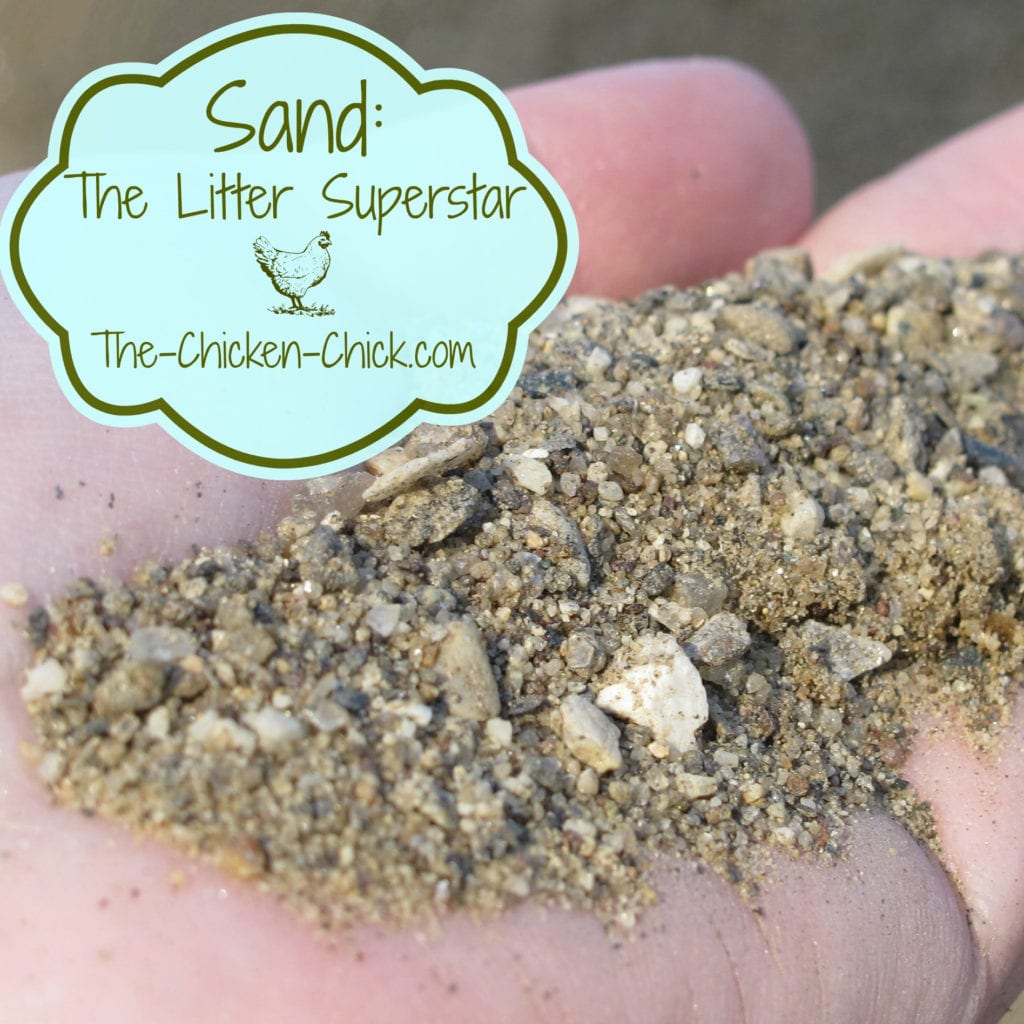
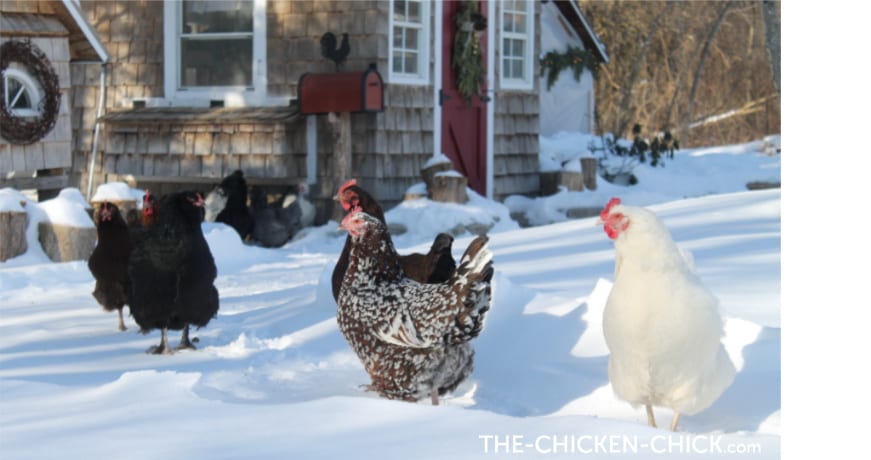

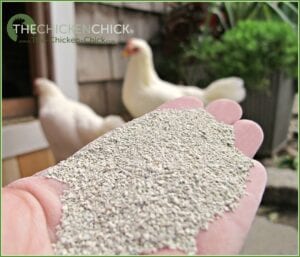
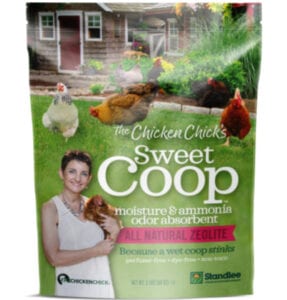
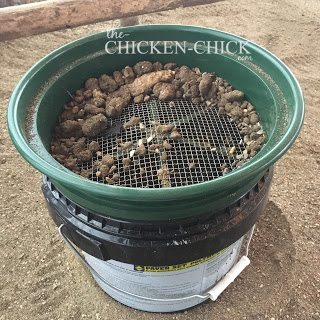
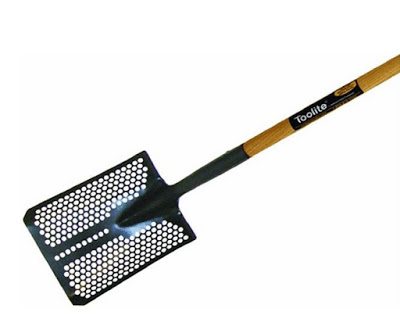

















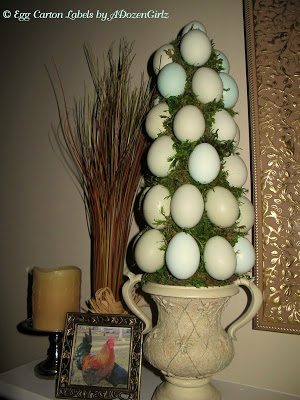

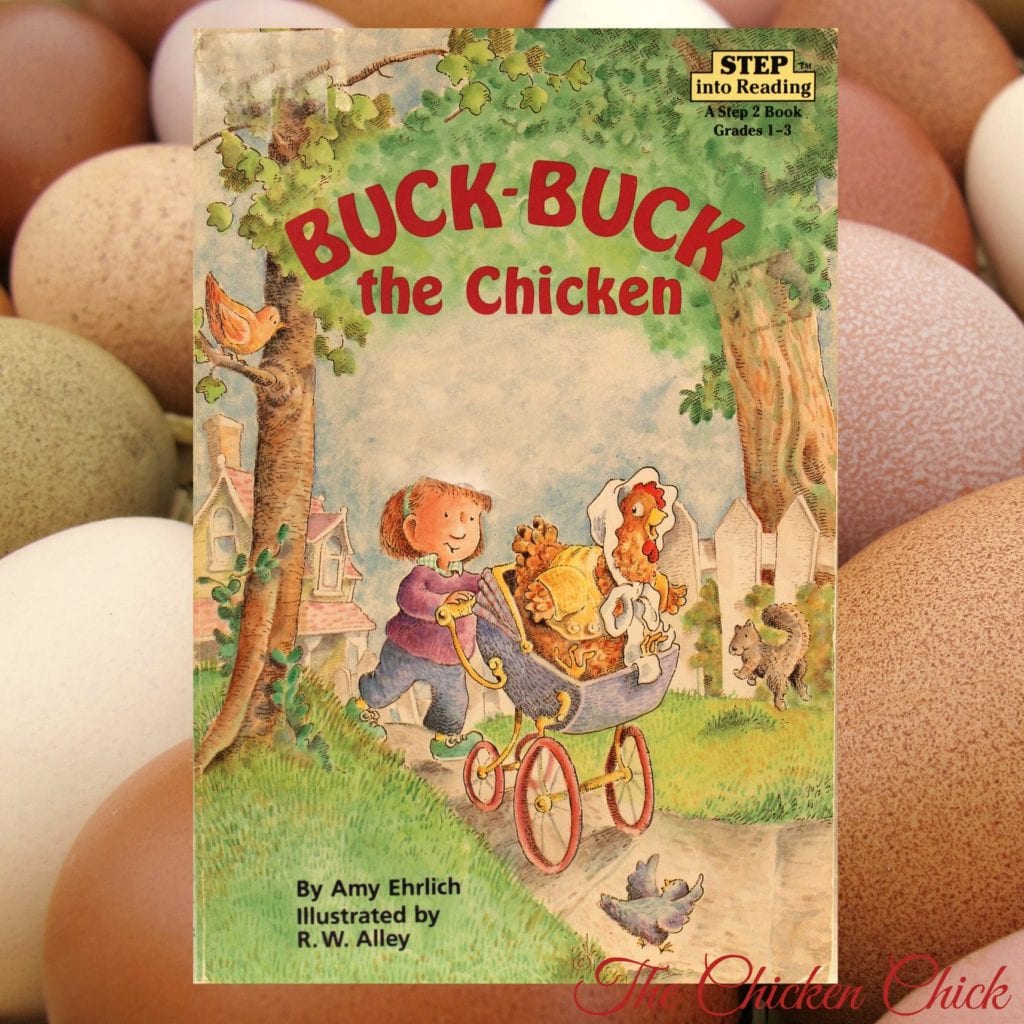















I want to buy some
We are newbies with 6 week old chicks. We need to elevate our coop and run due to a sloping hill nearby and muddy soil when it rains. What do you suggest we put as the foundation/first layer so any rain water can drain? We are thinking gravel? Then sand on top? Thank you!
Sand. Only sand. DEEP. Don’t mix anything into the sand or underneath it.
You probably answered this before, but what do you do with the sand from the coop after your annual cleaning?
Hi! Would beach sand work? I’m a complete newby at this! Our beach sand is fine in texture…
No, beach sand is not appropriate. The sand needs to be varied in texture, not homogenous. Salt can kill chickens if ingested in sufficient amounts. Also, beach sand should not be taken from the beach for environmental reasons.
Hi Kathy,
May I ask what vendor you use to buy your sand? I also live in CT.
Galasso’s in East Granby